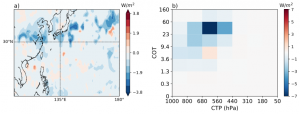Over the winter western North Pacific, the descending branch of the Hadley cell locates climatologically around 35˚N, while recently, it has been proved to shift poleward since the late 1970s. Correspondingly, the regional climate would be modulated by the migration of this subsiding zone. In our recent study, we examined the responses of the clouds, the cloud radiative effects, and the diagnostic fields associated with the poleward shift of the local Hadley cell subsiding edge (LHCSE) from a regional perspective (Wang and Iwabuchi, 2019).
We find that the interannual variability of the LHCSE is marked by anomalous rising motion, decreased large-scale static stability, and attendant increases of the mid-level cloud fraction over the climatological subsiding zone, around 35°N. By applying the radiative kernel method (Zelinka et al., 2012a; Zhou et al., 2013), the most sensitive cloud type to the movement of the LHCSE is identified to be cumulus congestus, with cloud-top pressures in the range of 440–680 hPa and optical thicknesses in the range of 23–60 (Fig. 1b). Increased fraction of this kind of cloud would lead to a net negative top-of-atmosphere radiation anomaly, and at the same time constrain the distribution of the anomalous precipitation over the East Asian coastal area.
図1. (a) Geographical distribution of the top-of-atmosphere (TOA) radiation flux anomaly associated with the varying LHCSE latitudes. Positive (negative) values indicate net inward (outward) radiation flux (W/m2). (b) Segregation of the radiation flux anomalies into cloud top pressure (CTP)–cloud optical thickness (COT) coordinates.
Publication
Wang, X., & Iwabuchi, H. (2019). Wintertime modulation of the local cloud and diagnostic fields by the hadley cell subsiding boundary over the Western North Pacific. Geophysical Research Letters, 46. https://doi.org/10.1029/2019GL083470
Reference:
Zelinka, M. D., Klein, S. A., and Hartmann, D. L. (2012a), Computing and partitioning cloud feedbacks using cloud property histograms. Part I: Cloud radiative kernels. J. Clim., 25(11), 3715-3735.
Zhou, C., Zelinka, M. D., Dessler, A. E., and Yang, P. (2013), An analysis of the short-term cloud feedback using MODIS data. J. Clim., 26(13), 4803-4815.

